How different did your dog look as a pup than he looks full grown? Some breed pups resemble a miniature rendition of their older selves. Other breeds change dramatically, not only in size, but in colors or coat textures. Five breeds are ready to share examples of their changing appearances. Who knows, but perhaps humans aren’t the only ones with an awkward adolescence?
Kerry Blue Terrier
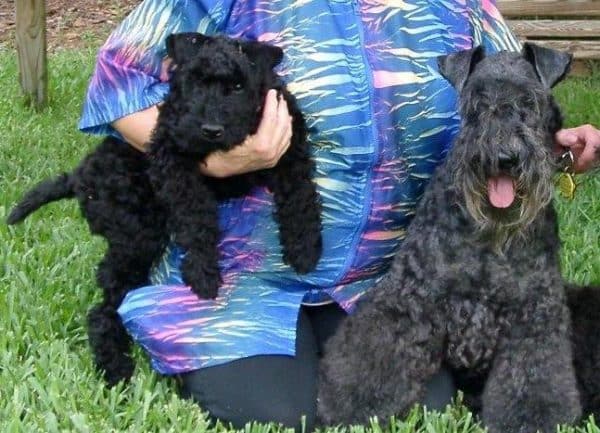
Kerry Blue Terrier pup and adult, courtesy Nancy Westbrook
We were bred in Ireland to hunt small game and birds. Not a slacker by any means, we also herded livestock, retrieved waterfowl, and watched over property. We’re called Kerry Blues of course, but we’re actually born black. We start to change color somewhere between 6 and 18 months old. Our final color is anywhere from a light silver blue to dark slate blue. Our puppy coat had a different texture than our adult coat too. The puppy coat was more open and softer in texture. As an adult, our coat is dense, silky, soft and wavy (but not curly). Regardless of shade, we’re true blue loyal companions to our family.
Dalmatian
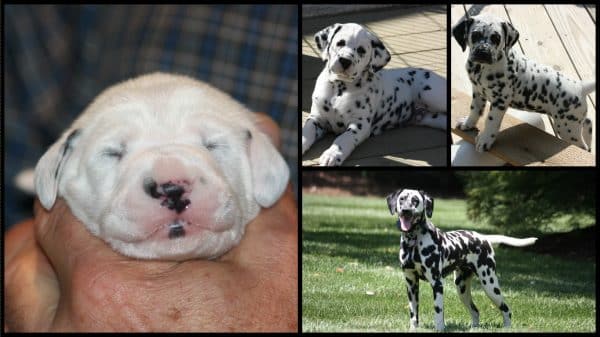
Dalmatian pups and adult, courtesy Toni Linstedt, DCA
We’re famous for our athleticism and our history of accompanying horse-drawn coaches and fire equipment. We’re also well-known for our sleek and glossy spotted coats. Did you know that unless we’re patched, we’re born white, with no spots to be seen? Actually our skin is pigmented (spotted) at birth, but you’ll probably only see this if we’re wet. Our spots gradually emerge, usually over a two week period. By the time we’re 2 to 3 weeks old, you’ll see the spots in our fur. Sometimes on those of us heavily spotted, the spots “explode,” or grow together. As we continue to grow, our spots become darker and better defined. And lastly, some of us develop more small spots, called ticking, when we’re old. Indeed we’re all about spots, from puppy-hood to our senior years!
Bearded Collie
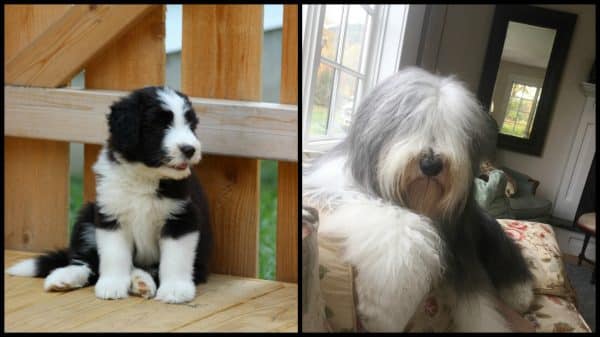
Bearded Collie courtesy Debbie Chandler
We Beardies, developed in Scotland, are hardworking herders that also drove livestock to market. Some call us the unicorns of the dog world, because of our changing colors. As pups, we are born black, blue, brown or fawn. Our notable coat color change period occurs between puppy hood to adolescence. Our families wait with bated breath to see our final colors. I was a dark black and white pup, and now in adulthood I’m a rather light black and gray. Our adult coat is always appropriately shaggy. I concede Beardie is a nifty name, but one of our old names, the Hairy Mou’ed Collie, was equally appropriate
Pomeranian
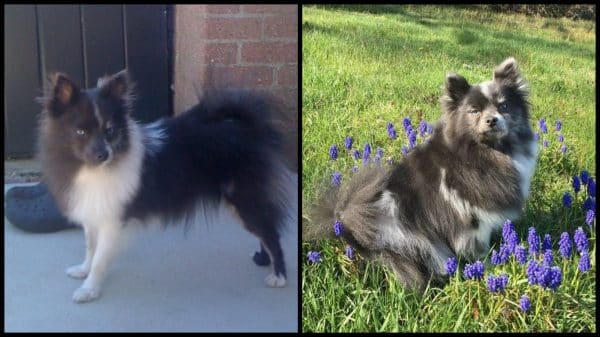
Pomeranian pup (left) in the “uglies” and adult, courtesy Jacky Mento
We’re an exceptionally exuberant pint-sized dog, bred down from the larger Spitz breeds in the Pomerania region. We’re only about 5 pounds, but we’re bold, nimble and confident. Our coats look like they’re high maintenance, but we simply need regular brushing (and extra brushing a few times a year when we blow coat). We didn’t vote on this, but you humans call the growth period between our puppy and adult coats the “puppy uglies.” Seems a bit harsh, but you seem to say it lovingly. Typically around 4 to 6 months of age, we lose our puppy coat and the adult coat develops in stages. Often our adult hair comes in first on our face, giving us monkey-like appearance of sorts. Our “uglies” are a normal phenomenon. Notice how my adult coat came in with a richer, fuller and even more beautiful texture? It’s worth the wait!
Bedlington Terrier
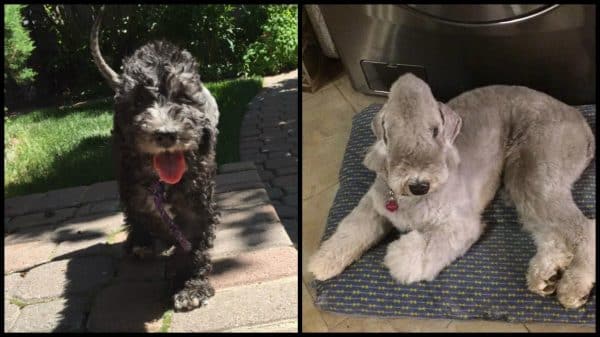
Bedlington Terrier pup and almost full grown dog, courtesy Diane Stille
We’re natural hunting Terriers, developed in England to keep vermin and rodents at bay. With our speed and determination, we could both go to ground for quarry, as well as pursue prey on the fly. Now many people comment about our similarity to lambs. To this I reply: Meh! Name me one lamb that races down prey! Now about our puppy appearance: We’re born with a soft coat, quite distinct from our adult coat. As puppies, our two main colors are blue and liver. As we mature, our coat develops a mixture of hard and soft hair that stands out from the skin. Adult coat colors can include blue, sandy, liver and some combinations. My adult coat has a linty cotton wool texture. But no, the word “Wool” isn’t an invitation to further lamb comments!
Top photo: Bearded Collie adult courtesy Debbie Chandler
Title photo: Dalmatian courtesy Toni Linstedt. DCA
The post Dog breeds that change dramatically as they grow! appeared first on Dogster.
No comments:
Post a Comment